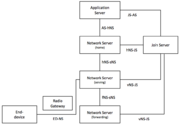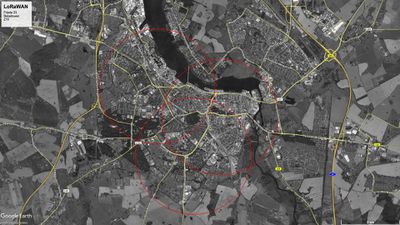Projekt LoRaWAN: Unterschied zwischen den Versionen
Aus Opennet
Thm (Diskussion | Beiträge) (→Anbindung) |
Thm (Diskussion | Beiträge) (→Plan) |
||
| Zeile 58: | Zeile 58: | ||
= Plan = | = Plan = | ||
| + | |||
| + | == Nutzen für Opennet == | ||
| + | |||
| + | * Neues Projekt | ||
| + | * Bereitstellen eines Community LoRaWANs in Rostock und ggfs. sonstwo | ||
| + | * Eigene Nutzungsmöglichkeiten | ||
== Standorte == | == Standorte == | ||
Version vom 14. März 2018, 11:24 Uhr
Inhaltsverzeichnis |
Knowledge LoRa / LoRa-WAN
Einsatzmöglichkeiten
- Low Energy, low throughput, high bandwidth, long range Übertragung
- Beispiel Sensordaten
- Über LoRa-WAN auch Anbindung ans Internet, im Idealfall überall, dazu Gateways notwendig
- https://de.wikipedia.org/wiki/The_Things_Network stellt solche Gateways als Community bereit
- https://www.youtube.com/watch?v=3cIGzwH-NI8
Protokoll
- Layer 1 - Chirp Spread Spectrum
- https://de.wikipedia.org/wiki/Chirp_Spread_Spectrum
- In Europa Frequenzen 433 MHz (ISM-Band Region 1) und 868 MHz (SRD-Band Europa)
- Reichweiten von 2 km (Stadtgebiet) über 15 km (Vororte) bis zu 40 km (ländliche Gebiete)
- Layer 2
- Bi-directional end-devices (Class A): End-devices of Class A allow for biirectional communications whereby each end-device’s uplink transmission is followed by two short downlink receive windows. The transmission slot scheduled by the end-device is based on its own communication needs with a small variation based on a random time basis (ALOHA-type of protocol). This Class A operation is the lowest power end-device system for applications that only require downlink communication from the server shortly after the end-device has sent an uplink transmission. Downlink communications from the server at any other time will have to wait until the next scheduled uplink.
- Bi-directional end-devices with scheduled receive slots (Class B): End-devices of Class B allow for more receive slots. In addition to the Class A random receive windows, Class B devices open extra receive windows at scheduled times. In order for the End-device to open its receive window at the scheduled time, it receives a time synchronized Beacon from the gateway.
- Bi-directional end-devices with maximal receive slots (Class C): End-devices of Class C have nearly continuously open receive windows, only closed when transmitting. Class C end-device will use more power to operate than Class A or Class B but they offer the lowest latency for server to end-device communication.
- Layer 3
- https://www.lora-alliance.org/for-developers
- LoRa-WAN ist eine Möglichkeit, ein Low Power Wide Area Network zu errichten
Hardware
Gateways
Endgeräte
- Anwendungen vor allem Sensordaten erfassen, Fernsteuern, Überwachen
- Diverse "Shields" für Ardoino und Co.
- Raspberry
- Sonstiges
Server-Software
- App-Server z.B. auch via AWS https://www.hackster.io/naresh-krish/integrating-lorawan-with-aws-iot-services-using-the-rak811-b0127d
Plan
Nutzen für Opennet
- Neues Projekt
- Bereitstellen eines Community LoRaWANs in Rostock und ggfs. sonstwo
- Eigene Nutzungsmöglichkeiten
Standorte
Bei 2km Reichweite in Städten würden wir mit den ersten drei Gateways schon die komplette Innenstadt abdecken.
Anbindung
Was wir tun müssten
- Gateways aufstellen
- LoRaWAN Network Server bereitstellen
- Eventuell Anbindung an The Things Network
- Standorte so planen, dass gesamte Stadt abgedeckt wird
Kosten
- Gateways ab 100,-EUR ohne Outdoor-Gehäuse und Antennen
- Eigene Clients zum Basteln je nach Anwendung


